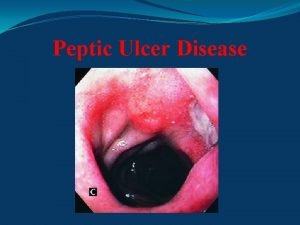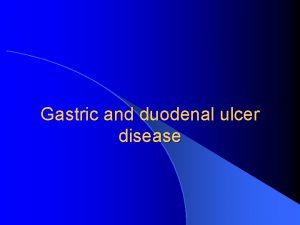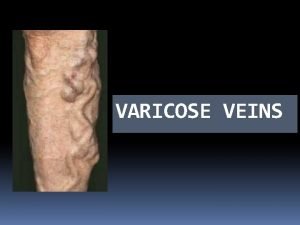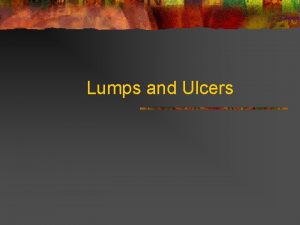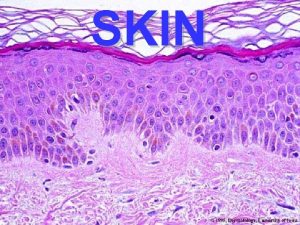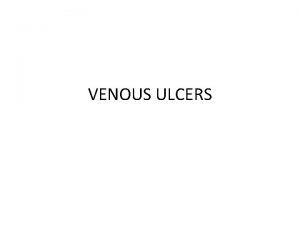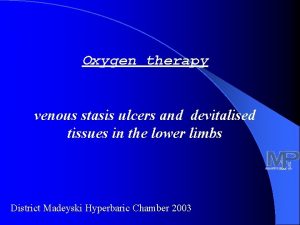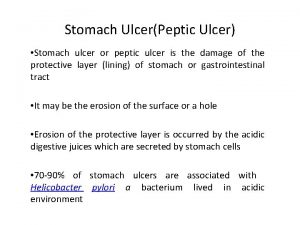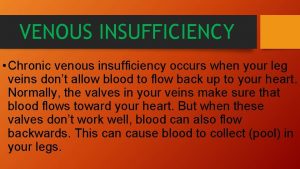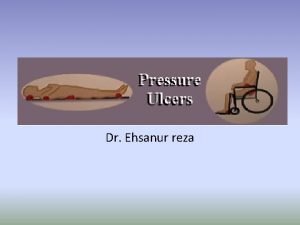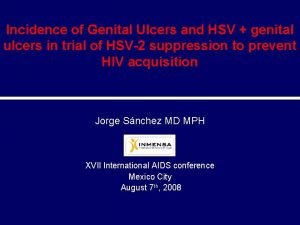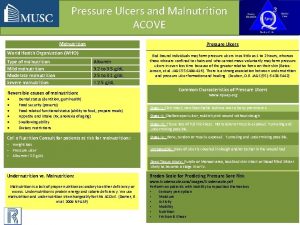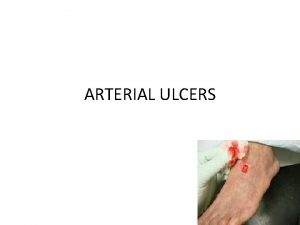VENOUS STASIS ULCERS Venous stasis ulcer occurs from

















- Slides: 17

VENOUS STASIS ULCERS

Venous stasis ulcer: • occurs from chronic deep vein insufficiency and stasis of blood in the venous system of the legs • An open, necrotic lesions that results when an inadequate supply of oxygen-rich blood and nutrients reaches the tissue • The result is cell death, tissue sloughing, and skin impairrment


• Decreased circulation to the area contributes to the development of infection and prolonged healing

CLINICAL MANIFESTATIONS • Varying degrees of pain may be reported, ranging from mild discomfort to a dull, aching pain • The skin is visibly ulcerated and has a dark pigmentation • Edema may be present • Ulcerations often occur around the medial aspect of the ankle • Pedal pulses are present

ASSESSMENTS • Pain • Predisposing factors such as thrombophlebitis, venous insufficiency, and/or diabetes mellitus are noted • Inspection of ulcerated areas: size, location, and condition of skin, color and temperature • Palpate pedal pulses, and observe presence of edema

DIAGNOSTICS • Venography and Doppler ultrasonography - Purpose of test utilize to confirm venous insufficiency and stasis



MEDICAL MANAGEMENT • Focusing on promoting wound healing and preventing infecitions • Intake of protein is essential becaue large amounts of protein in the form of albumin are lost through the ulcers • Also Vit. A and C and the mineral zinc to promote tissue healing • Debridement of necrotic tissue, antibiotic therapy, and protection of the ulcerated area are usual treatments

TYPES OF DEBRIDEMENT • Mechanical- by applying wet-to-dry dressing to the wound, dressing is applied damp, when dry, it is removed, pulling off the debris that has adhered to the dressing • Chemical- use of enzyme ointments such as Elase over the ulcer to break down necrotic tissue • Surgical- using of scalpel is done when other measures are unsuccessful

• Unna paste boots can be use to protect the ulcer and provides constant and even support to the area • A moist, impregnated gauze is wrapped around the foot and leg • It may be left on for 1 -2 weeks


Nx INTERVENTIONS • Perform dressing changes per physician order • Assess signs and symptoms of infections • Provide antibiotic therapy • Encourage nutritional intake to promote healing • Elevate extremities when sitting or lying to promote venous return and decrease the incidence of edema and venous stasis • Assess level of discomfort

PATIENT TEACHING • preventing infections • Maintaining peripheral tissue circulation • Avoiding venous stasis • Proper wound care and dressing changes

PROGNOSIS • Venous stasis ulcers are chronic condition caused by chronic insufficiency and delayed healing. Most venous ulcers heal with therapy.

 May kuster perforator
May kuster perforator Peptic ulcer disease anatomy
Peptic ulcer disease anatomy Longitudinal ulcers in typhoid
Longitudinal ulcers in typhoid Gastric ulcer
Gastric ulcer Ulcer niche and ulcer notch
Ulcer niche and ulcer notch Hour glass stomach
Hour glass stomach Billroth ii anatomy
Billroth ii anatomy Pratt test varicose veins
Pratt test varicose veins Excessive acid production
Excessive acid production Ulcer symptoms
Ulcer symptoms Continuous bedside pressure mapping
Continuous bedside pressure mapping History of lump
History of lump Peptic ulcer definition
Peptic ulcer definition Acute gastritis
Acute gastritis Hypo stasis
Hypo stasis Hypostatis
Hypostatis Stasis dermatitis
Stasis dermatitis Wei qi booster and stasis breaker
Wei qi booster and stasis breaker



